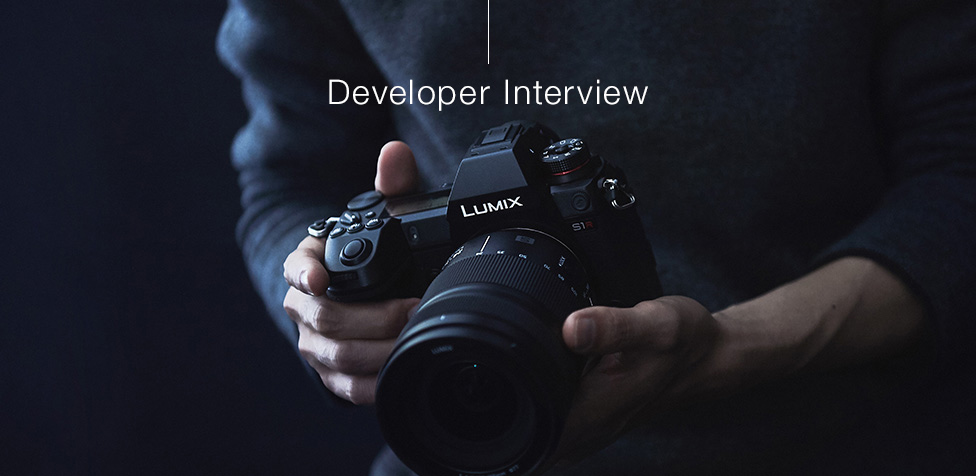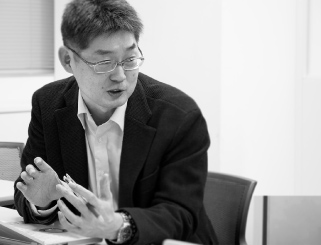
Beyond the Period of 10 Years
Our aim: performance that makes a camera a “work tool” for professional photographers.
- LUMIX has developed its first full-frame mirrorless cameras. Please tell us about the development background.
Kado:Professional photographers and photography enthusiasts around the world have high expectations for digital single-lens mirrorless (DSLM) cameras. The trend of camera shipments clearly indicates the high popularity of DSLM cameras. In Japan, the number of DSLM cameras shipped exceeded that of digital single-lens reflex (DSLR) cameras. The main driving force behind the growing demand for DSLM cameras is full-frame cameras. We foresaw this trend many years ago. To respond to customers’ expectations and needs, we began developing full-frame mirrorless cameras several years ago.
What was the focal point of the development of the LUMIX S1R/S1?

Kado: LUMIX GH5, GH5S and G9 in Micro Four Thirds System standard are already evaluated highly by professionals. However, we felt that in some aspects they were short of becoming main cameras to serve as “work tools” of professional photographers. In view of this, we decided to launch products in the new category called full-frame cameras. As a start, we began developing cameras that professional photographers would choose as their “work tools.”
Kazunori Kado
-Camera product planning
Please explain what you mean by a “work tool.”
Kado: We believe that a camera that serves as a professional photographer’s work tool must allow its user to manipulate precisely and click the shutter at any desired moment so that the user can capture expressive images exactly as intended. In developing the S1R/S1, we focused on three points: “expressiveness,” “high basic performance” and “operational ease.” Upon accomplishing them, we added benefits that only LUMIX can provide and also proposed something new.
- Exactly what kind of approach did you take for each of those points?
Kado: For expressiveness, we adhered to the LUMIX image-making philosophy, “Capturing It All,” for rendering life’s vitality and beauty in images. Based on this philosophy, we worked on achieving the image-making capability that would be made possible by the full-frame sensor. We also provided new functions such as High Resolution mode, which generates higher resolution images, and HLG Photo. Through these new functions, LUMIX proposes new photographic expressivity and new picture viewing style for the future.
For achieving high basic performance, focus performance is of utmost importance. We not only incorporated an auto focus function featuring the conventional Contrast AF and DFD technology into the full-frame system, but also increased the communication speed between the lens and sensor, revamped the automatic recognition function by adding an animal recognition feature, and provided Low Light AF in order to enable high-speed, high-precision focusing in a variety of shooting scenes. Our new full-frame digital cameras are equipped with a high-speed, high-precision shutter to realize a flash sync shutter speed of 1/320 second, not to mention the high-speed 1/8000 second. Furthermore, they offer a shutter life of 400,000 operations. What’s more, the Dual I.S. 2 suppresses camera shake even at the telephoto end by linking the Body I.S. (Body Image Stabilizer) and O.I.S. (Optical Image Stabilizer) in an advanced way. The new image stabilizer function works for 4K 60p/50p* video shooting. All in all, the S1R/S1 cameras offer the functions and specifications that will be appreciated by professionals.
* PAL area only.
- You have described only a few features and functions so far, but I am already excited.
Kado: There are many more to mention. The third point, operational ease, is extremely important. The Real View Finder with 5.76 million dots resolution is symbolic of our painstaking efforts to ensure easy operation. We also paid meticulous attention to details that cannot be expressed by the specifications, such as the user interface (button layout and menu), body rigidity, impact resistance, splash resistance and dust resistance.
It is easy to describe with words, but creating an easy-to-use design and achieving high build quality of the internal mechanisms often requires conditions that conflict with each other, so it is very difficult to attain both at the same time. One of the reasons that made it possible to accomplish both without compromise was the devotion and passion of all members involved in the development.
The optimal solution we contrived from the viewpoint of photographers was L-Mount.
- Please tell us about the process of developing and adopting the L-Mount.
Ejima: As a matter of fact, we began examining the development of full-frame cameras around 2010. At that time, we were considering collaboration with Leica Camera AG. However, our camera brand power was still weak in those years; thus, we concluded that even if we released a full-frame camera, customers would not show any interest. Therefore, we decided regrettably to halt the development project.
In a later year, we started strengthening our high-end camera models based on the Micro Four Thirds System standard, and introduced the GH5 and G9, which gained high acclaim from professional photographers and photography enthusiasts. Encouraged by the success of those products, we decided to restart the development of full-frame cameras in order to offer the best cameras possible that were loaded with all our advanced technologies. With a reaffirmed determination, we launched a new development project as stated earlier by Kado.
- So, was the use of the L-Mount decided at that time?

Rikiya Ejima
-Mount design
Ejima: No. At the beginning, we were considering the use of an original mount. That was because we placed importance on optical design flexibility in order to realize unprecedentedly high image quality that would surpass that of other camera makers’ flagship DSLR cameras. However, use of an original mount meant that a great many hours would be needed to develop and offer a full lineup of lenses. The target users of the LUMIX S1R/S1 were professional photographers according to the product concept. No matter how technologically innovated a camera is, it cannot serve as a work tool for a professional if the lens lineup is limited.
To deliver true benefits to professional photographers and photography enthusiasts, it was imperative to expand the lens lineup quickly.
We conducted examination repeatedly and fully utilized the knowledge acquired in the original mount development project. And then we determined that the L-Mount would be most suitable. The L-Mount would enable the use of not only LUMIX lenses but also the lenses offered by Leica Camera AG, thus expanding the range of mountable lenses significantly. So, we approached Leica Camera AG for collaboration, which led to the formation of the L-Mount Alliance.
- So, the decision to use the L-Mount was made from the photographers’ perspective.
Ejima:What made it possible was that the basic concept of the original mount we were preparing to develop was close to that of Leica Camera AG’s L-Mount. The L-Mount not only enabled us to pursue high image quality but also offered excellent maneuverability and functional extendibility. The well-balanced characteristics of the L-Mount matched exactly what we wanted.
Furthermore, we approached Sigma, a company which develops a variety of distinctive, high-performance lenses, for the purpose of offering a full line of lenses as soon as possible. The participation of Sigma in the L-Mount Alliance was very reassuring and encouraging. Through the three-partner alliance formed by Leica Camera, Sigma and Panasonic, each company can develop their lens products by incorporating their unique strengths and provide many choices to customers, so the customer benefit is huge.
• L-Mount is a trademark or registered trademark of Leica Camera AG.

